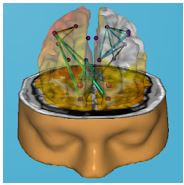 swLORETA image showing elevated alpha activity in the thalamus and cerebellum as well as other locations. swLORETA image showing elevated alpha activity in the thalamus and cerebellum as well as other locations. One of the new technologies I have for Neurofeedback is something called swLORETA z-score Neurofeedback. It is part of a program I used called Neuroguide. Traditional neurofeedback uses one or two electrodes on the head to increase or decrease a particular frequency or frequencies. swLORETA z-score Neurofeedback uses 19 electrodes on the head to train the brain in 3 dimensions. It divides the brain into over 12,000 voxels or pieces and calculates the brain activity at those locations. I then compare that data to a normative database to determine what areas of the brain are different from the average human. If those areas of the brain are different, and they relate to the symptoms a person is having, then we can re-train those areas of the brain. For the first time, swLORETA allows deeper structures in the brain like the cerebellum to be viewed using qEEG technology. The cerebellum is very important in balance and coordination disorders, conditions like Parkinson's and is also now even being found to be involved in things like attention. swLORETA stands for standardized weighted low resolution electromagnetic tomography analysis. Advantages to swLORETA Neurofeedback is that it is more specific than traditional neurofeedback. Because it is more specific, it is being reported to work faster than other forms of traditional Neurofeedback and may succeed where other forms of Neurofeedback have reached a plateau in progress. Neurofeedback can be used to treat anxiety, depression, PTSD, OCD, ADHD, Autism, insomnia, traumatic brain injury, and is being investigated for use in cognitive problems associated with COVID-19. You can be assured you are getting the latest and greatest in technology when choosing Neurofeedback at Tuttle Health, LLC. Call today to schedule an appointment. 727-509-3760.
1 Comment
 Neurolink Q links patient's symptoms to locations in the brain. Neurolink Q links patient's symptoms to locations in the brain. Are you wondering what part of your brain might be involved in the problem you are having? Yeah, there's an app for that! There is a new app out called Neurolink Q. It allows a person to enter into it whatever symptoms they might be having and see what parts of the brain may be involved in generating their symptoms. For example if a person has anxiety, it will show what parts of the brain may be involved in generating anxiety. I use it in conjunction with a program called Neuroguide to do Neurofeedback with patients. I use Neuroguide in conjunction with a program called swLORETA which allows me to train the brain in three dimensions.  swLORETA technology shows elevated electrical brain activity in an anxious traumatic brain injury patient, show here with the yellow and red colors. swLORETA technology shows elevated electrical brain activity in an anxious traumatic brain injury patient, show here with the yellow and red colors. Neurolink Q can be used with the doctor and patient to see what parts of the brain may be involved and then see how the patient's symptoms are changing over time. The questions assess things like anxiety, depression, post traumatic stress disorder (PTSD), obsessive compulsive disorder (OCD), chronic pain, insomnia, attention deficit hyperactivity disorder (ADHD), early dementia, Parkinson's disease, alexithymia, autism, cognitive issues related to the coronavirus and various issues related to traumatic brain injury or concussion. If you enter this information, Neurolink Q does not send your information anywhere so you do not need to be concerned about privacy. If you WANT to send it to me, we can arrange for that but it takes additional steps. You can download the app here: http://anineurolink.com/mobile/APPgallery.htm Call 727-509-3760 to schedule an appointment. I am proud to announce that I am now a diplomate in QEEG (quantitative electroencephalography) as determined by the International QEEG Certification Board. QEEG is the mathematical analysis of brainwave activity and the skill and technology behind Neurofeedback. This is an advanced level certification currently only held by 126 other people in the world. This demonstrates a level of mastery that is not typically seen in most people providing Neurofeedback.
I already had the experience using qEEG technology having practiced and studied under great mentors in the field recording and processing thousands of EEGs and then conducting Neurofeedback with those patients. However, I saw the opportunity to refine and advance my skills even further and I chose to get this advanced certification. While over 100,000 studies have evaluated the use of qEEG, there is very little standardization as to how proficient a person is in using the technology, especially when used in a clinical setting (i.e., working with patients). One of the biggest advancements this certification gives is the ability to screen and read EEGs like a medical doctor does which is different than how they are read for Neurofeedback. This allows me to screen EEGs more effectively for red flags that would require a referral to a neurologist. It also brought me up-to-date on latest advancements in the field and ways of treating patients using Neurofeedback. Neurofeedback can be used to train a variety of brain-based conditions such as anxiety, depression, Post Traumatic Stress Disorder (PTSD), Attention Deficit Disorder (ADD), Attention Deficit Hyperactivity Disorder (ADHD), Traumatic Brain Injury (TBI), Obsessive Compulsive Disorder (OCD), insomnia, chronic pain, migraines and autism. In collaboration with neurologists, it can also be used treat epilepsy. Call my office at 727-509-3760 to learn more and schedule an appointment. |
AuthorI'm a Chiropractic Physician, Psychotherapist and researcher. I'm interested in helping people live their lives to their full potential. That could be simply without pain. Or it could be without more complicated physical or mental health problems. Or it could be getting help in making changes in their life so that they can achieve their dreams. Archives
June 2023
Categories |
 RSS Feed
RSS Feed